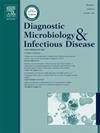治疗腰骶部包虫病的挑战和陷阱:从临床实践中汲取的经验教训
IF 2.1
4区 医学
Q3 INFECTIOUS DISEASES
Diagnostic microbiology and infectious disease
Pub Date : 2024-09-21
DOI:10.1016/j.diagmicrobio.2024.116542
引用次数: 0
摘要
目的腰骶部包虫病(LHD)是一种罕见的骨骼寄生虫病,累及腰骶部。在这项研究中,我们总结了腰骶部包虫病患者的诊断和治疗程序,以便为治疗这种罕见疾病提供启示。方法回顾性分析了 2000 年至 2023 年期间确诊的 16 例腰骶部包虫病患者。仔细评估了每位患者的医疗记录和随访详情。平均随访时间为(11.25 ± 6.41)年,为了解治疗的持久性和有效性提供了宝贵的资料。临床症状包括腰痛伴下肢麻木(25%)和大小便失禁(25%)。所有患者都接受了手术治疗,平均每位患者接受了 2.6 次手术。结论LHD是一种严重而复杂的骨骼寄生虫病,在诊断和治疗方面存在巨大挑战。有效的治疗需要采取综合策略,包括手术和其他疗法。本文章由计算机程序翻译,如有差异,请以英文原文为准。
Challenges and pitfalls in managing lumbosacral hydatid disease: Lessons learned from clinical practice
Objective
Lumbosacral hydatid disease (LHD), a rare skeletal parasitic disease that involves the lumbosacral region. In this study, we summarized the diagnostic and therapeutic procedures for patients with LHD to provide insights into managing this rare disease.
Methods
Between 2000 and 2023, 16 patients diagnosed with LHD were retrospectively analyzed. Each patient's medical records and follow-up details, were carefully assessed. The average follow-up period was 11.25 ± 6.41 years, providing valuable insights into treatment durability and effectiveness.
Results
The diagnosis was confirmed via imaging, serological tests, and pathological examination. The clinical symptoms included lumbago with lower limb numbness (25 %) and urinary and fecal incontinence (25 %). All patients underwent surgery, with an average of 2.6 surgeries per patient. Thirteen (81.25 %) patients experienced recurrence postoperatively.
Conclusion
LHD is a severe and complex skeletal parasitic disease with significant diagnostic and therapeutic challenges. Effective management requires a comprehensive strategy involving surgery and additional therapies.
求助全文
通过发布文献求助,成功后即可免费获取论文全文。
去求助
来源期刊
CiteScore
5.30
自引率
3.40%
发文量
149
审稿时长
56 days
期刊介绍:
Diagnostic Microbiology and Infectious Disease keeps you informed of the latest developments in clinical microbiology and the diagnosis and treatment of infectious diseases. Packed with rigorously peer-reviewed articles and studies in bacteriology, immunology, immunoserology, infectious diseases, mycology, parasitology, and virology, the journal examines new procedures, unusual cases, controversial issues, and important new literature. Diagnostic Microbiology and Infectious Disease distinguished independent editorial board, consisting of experts from many medical specialties, ensures you extensive and authoritative coverage.

 求助内容:
求助内容: 应助结果提醒方式:
应助结果提醒方式:


